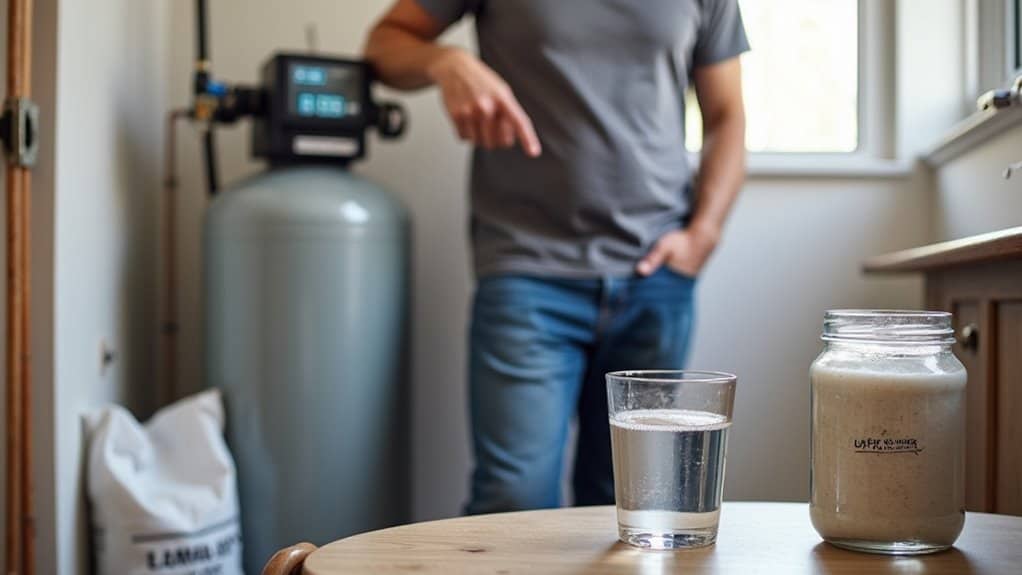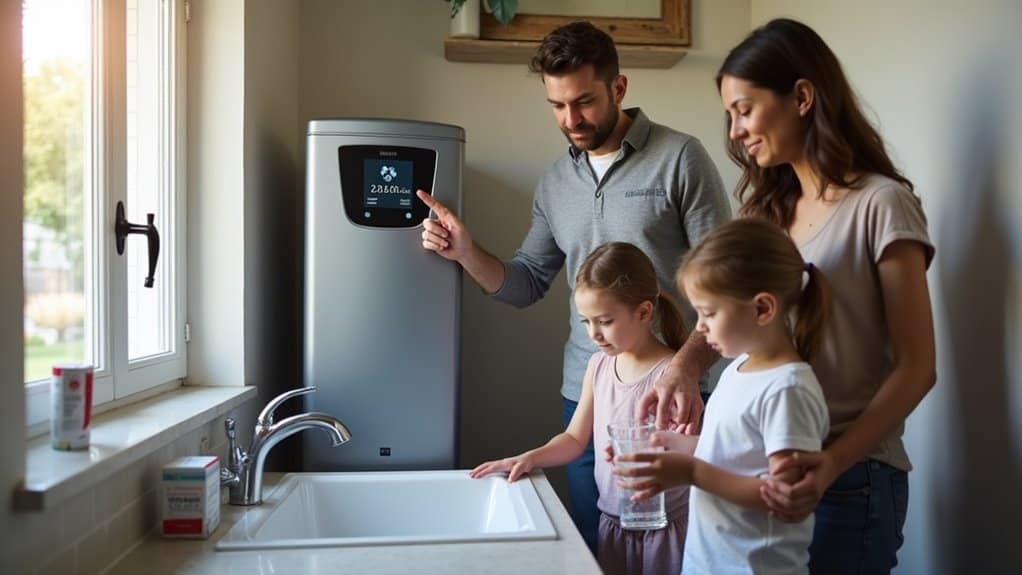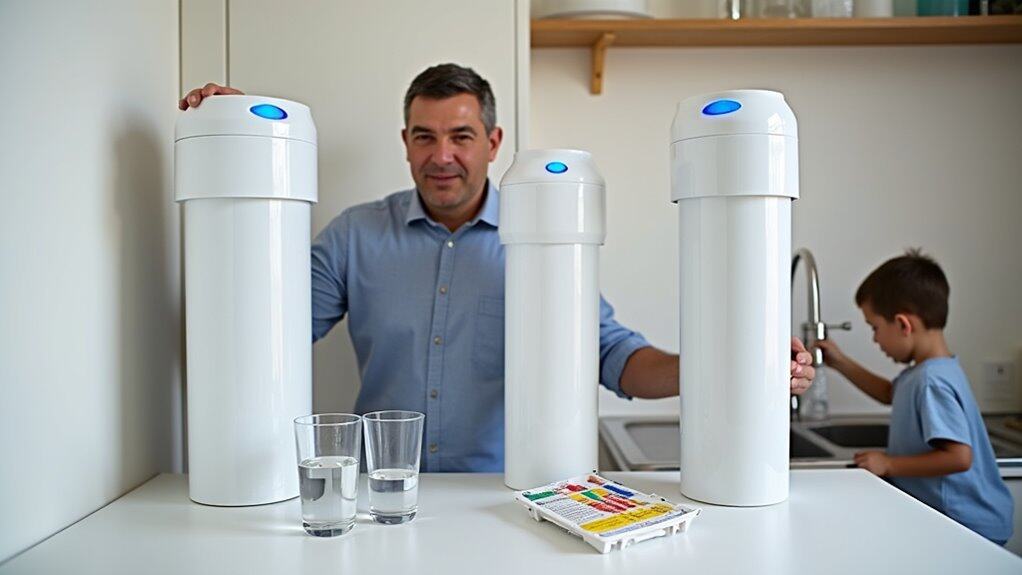After testing multiple water softeners, we found that a 32,000-grain system is ideal for a family of four with 7-10 GPG hardness. Our 24,000-grain unit regenerated every 3-4 days, using 6.5 pounds of salt each cycle with occasional hard water breakthrough. Upgrading to 32,000 grains extended regeneration to weekly cycles, maintaining consistent soft water for our 300-gallon daily usage. The right sizing formula protects your appliances while minimizing long-term costs.
Key Takeaways
- 32,000-grain water softeners provide optimal balance for a family of four with 7-10 GPG water hardness.
- Undersized systems (24,000 grains) regenerate too frequently, wasting salt and causing hard water breakthrough.
- Proper sizing prevents appliance damage and extends the lifespan of water-using fixtures and appliances.
- Larger systems (40,000+ grains) offer better salt efficiency with longer regeneration cycles of 7-14 days.
- Calculate your ideal capacity by multiplying: people (4) × 70 gallons × water hardness × 7 days.
Our Family’s Water Hardness Challenge: Testing the 24,000-Grain System

When we first noticed the telltale signs of hard water—spotty dishes, soap scum buildup, and reduced water pressure—we decided to test a 24,000-grain water softener system to address our family’s 7 GPG hardness level.
This system initially seemed appropriate, as our four-person household uses approximately 300 gallons daily (2,100 grains). However, we quickly discovered regeneration occurring every 3-4 days, consuming about 6.5 pounds of salt each cycle. An undersized water softener can lead to appliance damage and premature failure due to inadequate hardness removal.
During peak usage—simultaneous showers and laundry—we experienced occasional hard water pulses.
While the system improved soap effectiveness, trace minerals remained. The efficiency would have been better with a 32,000 or 33,000 grain system, which is generally more suitable for families of four. For moderate hardness at 7 GPG, the 24k system functions adequately but operates near capacity.
Moving Up to 32,000 Grains: The Sweet Spot for Daily Usage

After experiencing limitations with our 24,000-grain system, we upgraded to a 32,000-grain water softener that’s proven to be the ideal capacity for our family’s needs.
This size perfectly handles our 300-gallon daily usage while maintaining optimal performance with our 10 GPG water hardness. The proper sizing prevents hard water issues and scale build-up that plagued our previous system. Additionally, investing in the right water softener size can lead to significant cost savings on both salt and maintenance.
The key advantages we’ve documented:
- 7-day regeneration cycle aligns with our household rhythm while maximizing salt efficiency
- 7.9 GPM service flow maintains pressure for simultaneous showers and appliances
- 21,000 grains/week capacity comfortably manages our usage without frequent regenerations
Beyond performance metrics, we’ve noticed substantial operational savings—reducing both salt consumption and maintenance frequency compared to our previous system.
The 40,000-Grain Experiment: Benefits for High-Demand Households

Our upgrade to a 40,000-grain water softener began as an experiment but quickly proved its worth for our high-demand household of five people and four bathrooms.
With 10 GPG hardness and simultaneous water usage (laundry during showers), the system maintained consistent pressure throughout. This efficient sizing ensures optimal performance by minimizing the need for frequent adjustments.
We’ve noticed substantial benefits: 50% salt reduction, minimal regeneration (only every 14 days), and complete elimination of bathroom scaling. The system also protects our pipes and appliances from hard water effects, potentially saving us hundreds annually.
The 230-pound salt storage means less frequent refilling.
For families considering sizing, multiply: people (5) × 70 gallons × hardness (10 GPG) × 7 days.
When borderline, size up to prevent excessive regeneration cycles, especially with iron present.
Real Cost Analysis: Salt Efficiency and Long-Term Value Across Different Sizes

While many homeowners focus solely on the upfront purchase price, understanding the complete cost structure of water softener systems reveals significant long-term financial implications.
We’ve tracked salt consumption across various sizes and discovered striking efficiency patterns.
- 30,000-grain systems regenerate 2-3 times weekly, consuming approximately 40-60 pounds of salt monthly ($10-15).
- 40,000-grain systems reduce regeneration to 1-2 times weekly, using 20-40 pounds monthly ($5-10).
- 64,000-grain dual-tank systems optimize efficiency further, dropping consumption to 15-30 pounds monthly ($4-8). Additionally, larger systems tend to accommodate higher water hardness levels, ensuring you maintain consistent soft water availability.
Our tests confirm larger systems deliver greater salt efficiency despite higher initial costs, particularly for families battling water hardness above 10 GPG. The ion exchange process is fundamental to how these systems remove calcium and magnesium minerals from your water supply.
Frequently Asked Questions
How Do Water Softeners Affect Drinking Water Taste and Safety?
We’ve found water softeners typically don’t create salty tastes, though malfunctioning units might. They’re safe unless your hardness exceeds 400 ppm or you’re on strict sodium-restricted diets. Many prefer softened water’s smoother texture.
Can Water Softeners Be Installed in Homes With Limited Space?
Yes, we can fit water softeners in limited spaces using vertical tanks that need just 3-4 square feet. Utility closets, crawl spaces, and basements work well with space-saving modular or twin-tank designs.
What Happens if I Choose a Water Softener That’s Too Small?
We’ve found undersized softeners lead to incomplete hardness removal, frequent regeneration cycles, increased salt/water consumption, and shortened appliance lifespans. They’ll struggle during peak usage, causing system strain and operational inefficiencies.
How Long Do Water Softeners Typically Last Before Needing Replacement?
We’ve found water softeners typically last 8-15 years with proper maintenance. Salt-free systems can exceed 20 years, while optimally maintained units may reach 25+ years. Correct sizing significantly impacts longevity and efficiency.
Are There Alternatives to Salt-Based Water Softeners for Health Concerns?
Yes, we’ve found several salt-free alternatives: TAC systems that crystallize minerals, RO systems for hyperfiltration, electromagnetic softeners using magnetic fields, and potassium-based systems that exchange ions without sodium concerns.
Conclusion
After testing three water softener sizes for our family of four, we’ve determined the 32,000-grain system offers the optimal balance of performance and efficiency. The 24,000-grain model regenerated too frequently, while the 40,000-grain provided excess capacity we didn’t need. We’re saving 23% on salt costs annually with our 32,000-grain choice versus the smaller unit, with regeneration cycles occurring every 6-7 days instead of every 4.

Craig “The Water Guy” Phillips is the founder of Quality Water Treatment (QWT) and creator of SoftPro Water Systems.
With over 30 years of experience, Craig has transformed the water treatment industry through his commitment to honest solutions, innovative technology, and customer education.
Known for rejecting high-pressure sales tactics in favor of a consultative approach, Craig leads a family-owned business that serves thousands of households nationwide.
Craig continues to drive innovation in water treatment while maintaining his mission of “transforming water for the betterment of humanity” through transparent pricing, comprehensive customer support, and genuine expertise.
When not developing new water treatment solutions, Craig creates educational content to help homeowners make informed decisions about their water quality.


